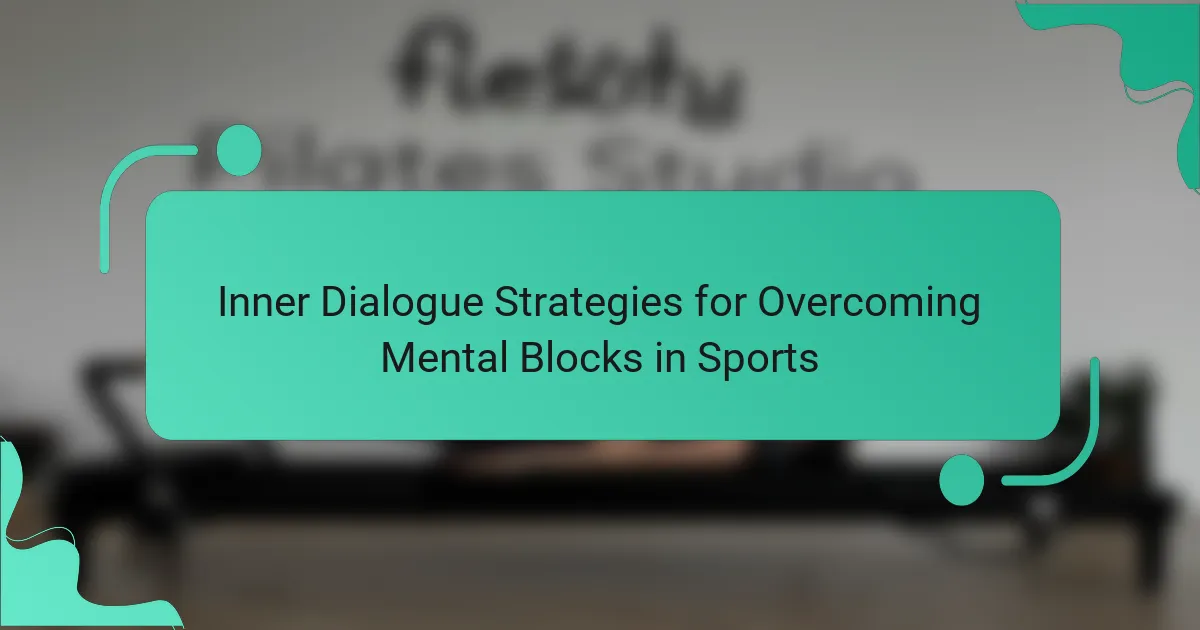Inner dialogue strategies are crucial for athletes facing mental blocks in sports. Techniques such as positive self-talk reinforce confidence, while visualization enhances performance through mental rehearsal. Reframing negative thoughts fosters resilience and promotes a learning mindset. Understanding cultural influences on self-talk can further empower athletes to improve focus and overcome barriers.

What are Inner Dialogue Strategies for Overcoming Mental Blocks in Sports?
Inner dialogue strategies effectively help athletes overcome mental blocks in sports. Techniques include positive self-talk, visualization, and reframing negative thoughts. Positive self-talk reinforces confidence, while visualization enhances performance by mentally rehearsing success. Reframing negative thoughts shifts focus from failure to learning opportunities, fostering resilience. These strategies build mental strength and improve overall performance in competitive environments.
How do mental blocks impact athletic performance?
Mental blocks negatively impact athletic performance by hindering focus, confidence, and decision-making. Athletes may experience anxiety, self-doubt, or overthinking, which can lead to decreased motivation and physical execution. Effective inner dialogue strategies, such as positive affirmations and visualization, can help athletes overcome these mental barriers. Research indicates that athletes who actively manage their inner dialogue report improved performance outcomes, highlighting the importance of mental resilience in sports.
What are the common types of mental blocks athletes face?
Athletes commonly face mental blocks such as self-doubt, fear of failure, overthinking, and negative self-talk. These blocks hinder performance and can be addressed through inner dialogue strategies.
Self-doubt manifests as uncertainty about abilities, often leading to hesitation during competition. Fear of failure creates anxiety that can paralyze an athlete, impacting focus and execution. Overthinking involves excessive analysis of performance, which disrupts flow and confidence. Negative self-talk reinforces limiting beliefs and undermines motivation.
Implementing positive affirmations and visualization techniques can help athletes overcome these mental blocks, fostering a more constructive inner dialogue.

What universal attributes define effective inner dialogue strategies?
Effective inner dialogue strategies share attributes that enhance mental resilience and focus in sports. Key attributes include self-awareness, positive reinforcement, and visualization techniques. Self-awareness allows athletes to recognize and challenge negative thoughts. Positive reinforcement builds confidence by emphasizing strengths and past successes. Visualization techniques enable athletes to mentally rehearse performance, reducing anxiety and improving execution. These attributes collectively foster a constructive inner dialogue that empowers athletes to overcome mental blocks.
How can positive self-talk enhance performance?
Positive self-talk significantly enhances performance by boosting confidence and focus. It helps athletes overcome mental blocks, enabling them to execute skills effectively. By fostering a positive mindset, athletes can reduce anxiety and improve resilience during competition. Regular practice of positive self-talk can lead to consistent performance improvements over time.
What role does visualization play in overcoming mental blocks?
Visualization plays a crucial role in overcoming mental blocks by enhancing focus and clarity. It allows athletes to mentally rehearse successful performances, which can reduce anxiety and build confidence. This technique transforms abstract goals into concrete images, making them more achievable. By visualizing success, athletes can reprogram their inner dialogue, fostering a positive mindset that counters negative thoughts and self-doubt.
How can goal setting facilitate a positive inner dialogue?
Goal setting enhances positive inner dialogue by creating clear objectives and fostering self-motivation. When athletes establish specific, measurable goals, they cultivate a constructive mental framework that encourages perseverance. This practice shifts focus from self-doubt to self-affirmation, reinforcing confidence and resilience. As a result, goal setting serves as a powerful tool for overcoming mental blocks in sports, promoting a positive mindset that is essential for peak performance.

What unique attributes set apart successful inner dialogue methods?
Successful inner dialogue methods stand out due to their focus on self-awareness, positive reinforcement, and tailored strategies. These methods incorporate unique attributes like visualization techniques, which enhance mental imagery, and cognitive restructuring, which shifts negative thoughts into constructive ones. Additionally, integrating mindfulness practices allows athletes to remain present, reducing anxiety and improving focus. The effectiveness of these methods often relies on personalized approaches that resonate with individual athletes’ experiences and mental blocks, making them more impactful.
How does the use of affirmations differ among athletes?
Athletes use affirmations differently based on their sport and psychological needs. Individual sports often emphasize self-affirmation, focusing on personal performance. Team sports may incorporate collective affirmations to build camaraderie and motivation. Unique attributes include the specificity of affirmations tailored to individual goals or team dynamics. Rarely, athletes may use affirmations in combination with visualization techniques, enhancing their mental preparation. Overall, the application of affirmations is a strategic tool for overcoming mental blocks in sports.
What are personalized mental scripts, and how do they work?
Personalized mental scripts are tailored inner dialogues that athletes use to overcome mental blocks. They work by reinforcing positive thoughts and visualizations, enhancing focus and confidence during performance. These scripts can include affirmations, specific imagery, and strategies to manage anxiety, ultimately fostering a resilient mindset.

What rare attributes contribute to exceptional inner dialogue strategies?
Exceptional inner dialogue strategies often rely on rare attributes such as self-compassion, emotional regulation, and mindfulness. These traits enhance athletes’ mental resilience, enabling them to navigate challenges effectively. Self-compassion allows for a supportive internal voice, reducing negative self-talk. Emotional regulation helps manage anxiety and maintain focus during competition. Mindfulness fosters present-moment awareness, improving concentration and decision-making. These rare attributes contribute significantly to overcoming mental blocks in sports.
How can athletes leverage their personal experiences in inner dialogue?
Athletes can leverage personal experiences in inner dialogue to overcome mental blocks by reframing negative thoughts into positive affirmations. This strategy enhances self-awareness and builds resilience. By reflecting on past successes, athletes can create a mental framework that encourages confidence and focus. Engaging in visualization techniques further helps solidify these positive dialogues, allowing athletes to mentally rehearse their performances.
What uncommon techniques have elite athletes used to overcome mental barriers?
Elite athletes utilize uncommon inner dialogue strategies to dismantle mental barriers. Techniques include visualization, reframing negative thoughts, and employing self-compassion. For instance, visualization allows athletes to mentally rehearse success, enhancing confidence. Reframing negative thoughts transforms challenges into opportunities for growth. Self-compassion fosters resilience, enabling athletes to recover from setbacks. These strategies not only improve performance but also reinforce mental fortitude.

How do cultural perceptions influence inner dialogue in sports?
Cultural perceptions significantly shape inner dialogue in sports by influencing athletes’ self-talk and mental resilience. These perceptions can create mental blocks or enhance performance through positive affirmations. For instance, cultures that emphasize collectivism may foster supportive inner dialogues, while those valuing individualism might lead to self-critical thoughts. Athletes can leverage cultural insights to develop strategies that transform negative self-talk into constructive motivation, enhancing focus and performance. Understanding these dynamics allows athletes to overcome mental barriers and improve their overall mental game.
What regional differences exist in approaches to mental training?
Regional differences in approaches to mental training often reflect cultural attitudes toward sports and mental health. For instance, in North America, there is a strong emphasis on individualistic strategies, such as visualization techniques and self-talk, to enhance performance. In contrast, many Eastern cultures may prioritize collective approaches, focusing on team dynamics and shared mental resilience.
Additionally, the integration of technology in mental training varies; Western countries frequently utilize apps and online platforms for mental coaching, while some regions may rely more on traditional methods like mentorship and face-to-face guidance. These differences highlight how cultural context shapes the effectiveness and adoption of inner dialogue strategies for overcoming mental blocks in sports.

What are best practices for implementing inner dialogue strategies?
To implement inner dialogue strategies effectively, focus on clarity, consistency, and positivity. Identify negative thoughts and replace them with constructive affirmations. Practice visualization techniques to enhance performance. Establish a routine for self-reflection to monitor progress and adjust strategies as needed. Engage in mindfulness practices to maintain focus during competition.
What common mistakes should athletes avoid when using inner dialogue?
Athletes should avoid negative self-talk, overthinking, and unrealistic expectations when using inner dialogue. These mistakes can hinder performance and increase anxiety. Focusing on constructive and positive affirmations enhances confidence and mental resilience. Additionally, neglecting to practice inner dialogue during training may lead to ineffective use during competition.
How can athletes optimize their inner dialogue for peak performance?
Athletes can optimize their inner dialogue by using positive affirmations and visualization techniques. These strategies help to overcome mental blocks and enhance focus. Practicing self-talk that emphasizes strengths and past successes can reinforce confidence. Additionally, setting specific performance goals allows athletes to maintain a constructive mindset during training and competition. Regularly reflecting on progress cultivates resilience and adaptability, essential for peak performance.
What expert insights can enhance the effectiveness of inner dialogue strategies?
Expert insights can significantly enhance inner dialogue strategies by promoting self-awareness and resilience. Techniques like visualization and positive affirmations help athletes reframe mental blocks. Research indicates that structured self-talk can improve focus and performance. Additionally, incorporating mindfulness practices fosters a non-judgmental awareness of thoughts, which can reduce anxiety and enhance clarity.
